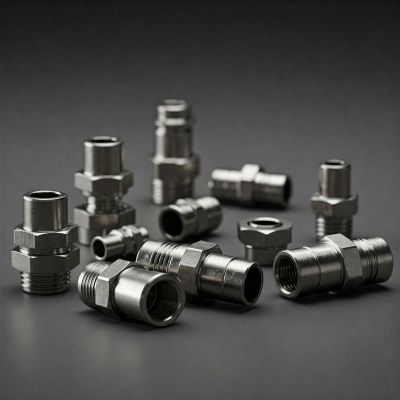SAE flare fittings play a crucial role in fluid and gas systems, ensuring reliable, leak-proof, and durable connections. These fittings are widely used in hydraulic systems, refrigeration, automotive, aerospace, and industrial applications due to their high resistance to vibration and pressure fluctuations.
Understanding their sizes, materials, and applications is essential for selecting the right fittings for any system.
What Are SAE Flare Fittings?
SAE flare fittings are mechanical connectors that utilize a 37° flare angle to create a tight, metal-to-metal seal. These fittings are designed to connect tubing or hoses in high-pressure applications, ensuring a secure and leak-proof joint.
How SAE Flare Fittings Differ from Other Fittings
➡️ Compression Fittings: Use a ferrule and nut system, while flare fittings use a flared tube end.
➡️ Pipe Fittings: Depend on thread engagement, whereas flare fittings use a mechanical seal.
➡️ JIC Fittings: Have the same 37° flare but follow different manufacturing and pressure standards.
SAE Flare Fitting Sizes
SAE flare fittings come in a range of sizes that follow a standardized measurement system. These sizes are designated using dash numbers, which correlate with the tubing’s outer diameter (OD).
Common SAE flare fitting sizes:
|
Dash Size |
Tube Outer Diameter (OD) |
|
-3 |
3/16 inch |
|
-4 |
1/4 inch |
|
-5 |
5/16 inch |
|
-6 |
3/8 inch |
|
-8 |
1/2 inch |
|
-10 |
5/8 inch |
|
-12 |
3/4 inch |
|
-16 |
1 inch |
Selecting the correct SAE flare fitting size ensures optimal flow rate, pressure resistance, and compatibility with your tubing system.
Materials Used in SAE Flare Fittings
The choice of material significantly impacts the durability, corrosion resistance, and pressure rating of SAE flare fittings.
Common Materials and Their Properties
➡️ Brass: Highly corrosion-resistant, commonly used in gas, refrigeration, and plumbing systems.
➡️ Steel: Strong and durable, ideal for hydraulic applications where high pressure is a factor.
➡️ Stainless Steel: Offers superior resistance to corrosion and extreme temperatures, widely used in high-pressure environments.
➡️ Aluminum: Lightweight and corrosion-resistant but less commonly used in heavy-duty applications.
Choosing the right material extends the lifespan of the system and ensures optimal performance.
Applications of SAE Flare Fittings
SAE flare fittings are indispensable in various industries due to their reliability, leak-proof sealing, and high-pressure capabilities.
Key Applications:
1. Hydraulic Systems: Used in high-pressure fuel and fluid lines.
2. Refrigeration & HVAC: Essential for leak-proof connections in cooling and air-conditioning systems.
3. Gas & Fuel Lines: Frequently used in propane, natural gas, and fuel delivery systems.
4. Aerospace & Automotive: Critical for fluid transfer in aircraft and vehicle fuel lines.
5. Industrial Equipment: Found in heavy machinery, manufacturing, and oil & gas industries.
Benefits of SAE Flare Fittings
SAE flare fittings offer numerous advantages over other types, making them a preferred choice in demanding applications.
Key Benefits:
➡️ Leak-resistant Design: The metal-to-metal sealing prevents leaks.
➡️ High-pressure and Temperature Resistance: Suitable for extreme environments.
➡️ Reusability: Can be disassembled and reused without compromising performance.
➡️ Compatibility: Works with various tubing materials, including copper, steel, and aluminum.
How to Properly Install SAE Flare Fittings
Proper installation ensures a secure, leak-proof connection and prevents premature failures.
Tools Required:
➡️ Flare nut wrench
➡️ Tubing cutter
➡️ Deburring tool
➡️ Flaring tool
Step-by-Step Installation Guide:
1. Cut the Tubing: Ensure a clean, square cut to seal properly.
2. Deburr the Edges: Remove sharp edges to prevent damage to the flare fitting.
3. Flare the Tube End: Use a 37° flaring tool for a precise flare.
4. Assemble the Fitting: Insert the flared tube into the fitting and tighten the flare nut securely.
5. Check for Leaks: Pressurize the system and inspect for any signs of leaks.
Common Mistakes to Avoid:
➡️ Over-tightening: Can cause the flare to crack.
➡️ Improper Flaring: Using the wrong flare angle can lead to leaks.
➡️ Skipping Deburring: Rough edges can compromise the seal.
Maintenance and Troubleshooting Tips
Regular maintenance is crucial for ensuring the longevity and performance of SAE flare fittings.
Maintenance Tips:
➡️ Inspect fittings periodically for wear, corrosion, or cracks.
➡️ Ensure proper tightening without over-compressing the flare.
➡️ Clean fittings to remove debris or buildup that may cause blockages.
Troubleshooting Leaks:
➡️ Check the Flare: Ensure it is properly formed and free from cracks.
➡️ Inspect the Seal: Ensure no dirt or debris is interfering with the connection.
➡️ Verify Tightening: Re-tighten the flare nut if necessary, but avoid over-torquing.
Conclusion
SAE flare fittings are essential components in hydraulic, gas, and fluid transfer systems, offering durability, leak-proof sealing, and compatibility with various materials. Their high-pressure resistance, reusability, and versatility make them a preferred choice in multiple industries.
By selecting the right size and material and following proper installation techniques, users can ensure optimal performance and longevity.
Post time: Mar-07-2025


